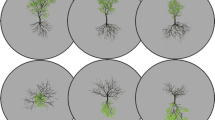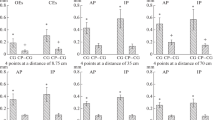Abstract.
The purpose of this research was to determine the reference axes used by the visual system to specify direction of motion of objects by the visual system at the perceptual level. Ten young adults aligned motion of a moving luminous dot on a computer display to body-fixed and external vertical and horizontal plane axes while operating in a dark room. Accuracy of aligning dot motion to earth-fixed vertical, a displayed luminous line (external visual axis) of varied orientations, and head and trunk longitudinal axes was tested in one experiment with the display in the vertical frontal plane. In a second experiment, dot motion was aligned to head and trunk anterior/posterior (A-P) axes and to an external visual axis presented on a horizontal computer screen. Head and trunk orientations were varied in the frontal plane (left/right tilt) when testing vertical plane axes and by rotation of the head and/or trunk about a vertical axis when testing horizontal plane axes. Perceptual errors were lowest when aligning to earth-fixed vertical in the vertical plane and to an external oblique line in the horizontal plane when head and trunk orientations were varied. Perceptions of horizontal plane motion direction were accurate relative to the trunk-fixed A-P axis when only head orientation was varied, but large errors were made when trunk orientation was varied. Proprioceptive influences on visual perceptions of motion direction were shown by a dependence of perceptual errors on trunk and neck orientations when aligning to all axes. Furthermore, when aligning motion to an external line, the errors depended on orientation of the line in addition to trunk and neck orientations, but not when aligning to intrinsic axes or earth-fixed vertical in the presence of an external line. We conclude that the visual motion system defines direction relative to earth-fixed vertical and an external horizontal reference axis when available. The trunk-fixed A-P axis can be used to accurately define motion direction when operating without an external reference if a neutral trunk orientation is maintained.
Similar content being viewed by others
Author information
Authors and Affiliations
Additional information
Electronic Publication
Rights and permissions
About this article
Cite this article
Darling, W.G., Pizzimenti, M.A. A coordinate system for visual motion perception. Exp Brain Res 141, 174–183 (2001). https://doi.org/10.1007/s002210100866
Received:
Accepted:
Issue Date:
DOI: https://doi.org/10.1007/s002210100866




